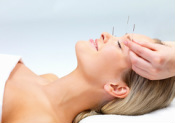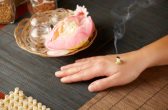Acupuncture
|
What is Traditional Chinese Medicine?
Traditional Chinese Medicine, or TCM, which is a medical system rooted in ancient Eastern philosophy. It includes many different treatment modalities, including acupuncture, acupressure, moxibustion, cupping, guasha, tuina, electro-stimulation, tai chi, qi gong and nutrition. It has been utilized for thousands of years, long before medicine became what we know it as today. TCM relies heavily on the observation of natural cycles and the changes we see during these cycles, which it then applies to the human body. An Eastern practitioner hence will observe each patient as a unique ecosystem, and with his or her diagnosis will identify areas of imbalance within this ecosystem. This also allows us to see the connection between seemingly unrelated symptoms and different diseases.
Many patients come to see us with a long list of different ailments, each of them requiring them to see a different doctors. For example, a patient presenting with depression, menstrual irregularities, cramping in the legs, high blood pressure, and visual disturbances will will be treated by several specialists - a psychologist or psychiatrist for the depression, an OB/GYN for the menstrual issues, an optometrist for the vision problems, and a family practitioner for the cramping and blood pressure control. Many of the treatment approaches will include various pharmaceutical drugs, many of which have considerable side effects. Even with these treatments, some of these conditions may never be resolved completely. An Eastern medicine practitioner will understand that all these symptoms are linked to the same imbalance in the patient (in this case a Liver Qi imbalance), and by balancing the energetics of the liver, all four symptoms will subside and health will be restored. This balancing is achieved by acupuncture, herbal teas, and by lifestyle and dietary changes, all of which have little or no side effects. What is Acupuncture and how does it Work?
Acupuncture is part of TCM, and has been used in China for more than 2,500 years as a way to attain and maintain health. It is based on the principle idea that a life force or energy called "qi" or "chi" flows through the body in pathways called meridians. These meridians, or channels, can be seen as the infrastructure of the body that ensures all parts of the body are supplied with the necessary nutrients, warmth and energy. If these meridians become blocked, or if the energy circulating in them becomes too weak and deficient, disease develops. For example, a channel can be blocked by injury or poor posture, and that in turn can lead to acute and chronic pain. Also, surgeries and the associated scarring can impair proper meridian flow, which can lead to chronic pain, lack of sensation or other disease presentations in the local area. Poor digestion can lead to reduced production of qi which can lead to chronic fatigue, low immune function or autoimmune diseases, and stress can lead to erratic movement of energy in the channels, which often presents as emotional issues like anxiety, depression, or insomnia.
To correct these imbalance, the practitioner inserts very fine needles into key points along the meridians to help the body rebalance itself. There are hundreds of points on the body, and each one has its own set of indications and functions. Some points clear heat and infections, others nourish and support the body. Some move energy to alleviate pain, others help with expelling pathogens (i.e. for colds and the flu), or draining water (i.e. for edema or urinary issues). The point combinations practitioners use will always address the symptoms as well as the root causes of the disease. |
Acupuncture
During acupuncture, needles as thin as 0.16 millimeters are inserted into specific points on the body. Since the needles are so thin, acupuncture is generally pain-free.
Moxibustion
During moxibustion, an herb called moxa (also known as mugwort) is applied to gently warm the affected acupuncture point or painful area. This can be done by putting a cone of moxa over the needles to transmit the heat deeper into the tissue, or by holding a stick of burning moxa over the affected area without needling.
E-stim
E-stim is used to increase the pain-relieving effects of acupuncture. During the treatment, a mildly pulsating electrical current is applied to selected needles. This is very similar to the electrical muscle stimulation many chiropracters apply before adjusting the patients.
|
Acupressure
Acupressure is a great option for people who are afraid of needles and for pediatric patients. The practitioner will stimulate specific points and areas of the body by gentle pressure.
Cupping
Cupping is often used to alleviate pain, or to fight off the beginning of a cold. The practitioner will apply a glass suction cup to the skin. With stationary cupping, the vessel is left in one place. In the case of running cupping, the suction cup will be moved on the skin, and the sensation the patient experiences is similar to that of a strong massage.
Tuina
Tuina is a form a massage that uses very light touch to manipulate the body's energy, or Qi. It can be used for pain anywhere in the body, and is also a vital part of facial rejuvenation treatments. Tuina is also a great option for children and infants, and people who are afraid of needles.
|
|
Acupuncture FAQs
1. Does acupuncture hurt?
No, it doesn't. The needles used are extremely thin, some as thin as 0.14 millimeters, so most people will not feel anything. Some patients report feeling sensations of heaviness, tingling or heat at the insertion site. All these are desired effects because they indicate that the qi of the body has responded to the needle. 2. I don't like needles. Is acupuncture still an option for me? Absolutely. Make sure to let your acupuncturist know that you have a fear of needles. Depending on how you feel during the visit, your practitioner will either choose very few points and the thinnest needles, or they may get you started with acupressure, which is the process of stimulating acupuncture points by applying pressure to the areas. Also, most conditions can be successfully treated with cupping, herbs and nutritional adjustments if needles really are not an option. 3. Is acupuncture safe? Yes. If performed by a licensed acupuncturist, acupuncture is very safe and carries minimal risk of injury. The most common side effects of acupuncture include slight bruising or short-term tenderness at the needling site. Acupuncturist in California spend close to 1000 hours in a clinical setting treating patients under the supervision of licensed practitioners, and spend a total of 4 years full-time in school, learning everything from Western medical principles and treatments to TCM principles and correct needling techniques and point indications. Compliant with state law, we use only sterile disposable needles that are disposed after each treatment. 4. My regular doctor offers acupuncture. What is the difference between an MD performing medical acupuncture and a licensed acupuncturist doing acupuncture? In California, the licensing board for acupuncture requires that "the total number of hours of all theoretical training shall consist of a minimum of 1,548 hours, and the total number of hours of clinical instruction shall consist of a minimum of 800 hours" for an acupuncturist to be licensed in this state. At Yo San University, students spend 120 hours practicing correct needling techniques in class, 120 hours observing practitioners and interns treating patients in a clinical setting, and another 840 hours treating patients under the supervision of licensed acupuncturists in the university clinic and various externships. This totals up to more than 2,500 hours of training. In contrast, MDs performing medical acupuncture are only required to complete a minimum of 300 hours in acupuncture-specific instructions. Would you trust a surgeon who only took a few weekend seminars to learn how to operate? When performing acupuncture, western MDs use a certain set of points to mainly control the symptoms, which allows little consideration for the constitutional differences in patients and the underlying root causes. An acupuncturist who is trained in the theories and principles of Eastern medicine will be able to take into account these differences. The licensed acupuncturist will hence be able to provide a treatment that is completely tailored to each individual patient and address root causes of disease as well as the symptomatic branches that are presented. |
Your First Visit
If you have never had acupuncture before, the first visit can be very intimidating. Here is what you can expect on your first visit, and also a few tips on how to be prepared.
|






